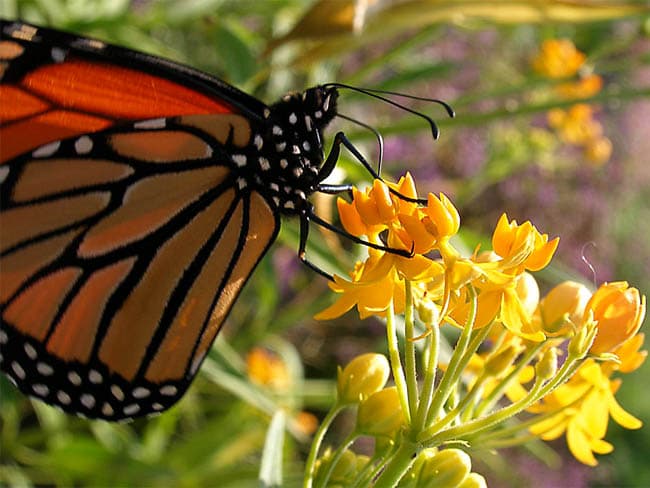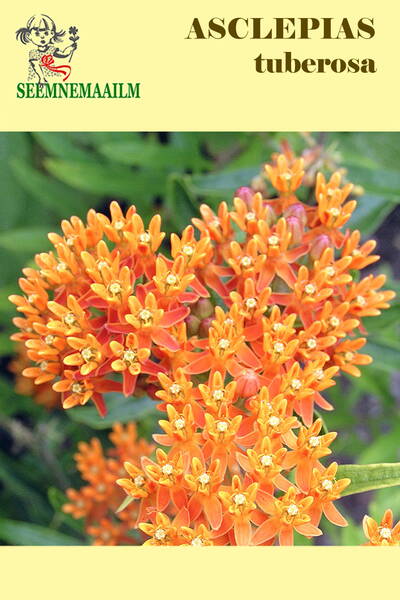A perennial in the family Asclepiadaceae with bright orange flowers.
Origin: North America.
Flowering plant height: 60-70 cm.
Foliage: dark green, stems and leaves are pubescent, lanceolate.
Distance between plants: 60 cm.
Natural flowering period: June - August.
Flowering: in the first year.
Winter hardiness zones: Z3 – Z8.
Soil requirements: sandy or rocky, well-drained.
Use: good for cutting.
1,0 g = 165 seeds.
It has been cultivated as a medicinal plant for a long time. A good honey plant. It is used for decorative purposes as a potted plant; it can serve as a successful addition to various compositions, as a soloist, and also for cutting. Large inflorescences adorn the shoots from mid-summer and throughout almost the entire fall. For the swallow to survive the winter well in its permanent place, good shelter is required.
Agrotechnics.
Any cultivated soil is suitable for this plant, but fertile, slightly acidic loams are desirable.
It must be taken into account that the timing of sowing seeds for various decorative purposes differs:
for potted and greenhouse crops with winter flowering - summer;
for summer flowering in the year of sowing - winter;
for forcing for 8-10 weeks - at the end of winter.
Seeds are germinated for 2-3 weeks at a constant temperature of +21+24°C. At the same time, illumination is produced. Crops can be sprinkled with vermiculite. After the first leaves appear, the temperature is slowly reduced to +18+20°C. The seedlings are transplanted to a permanent location when the threat of frost has passed. During the growing process, regular watering, loosening, and weeding of the plots are carried out.

This hardy perennial is well known for its ability to attract butterflies. If you want butterflies in your garden, just plant a few of these little jim-dandies and the butterflies will come flocking.
Perennial growing to 0.75m by 0.45m . It is hardy to zone 3. It is in flower from July to September. The flowers are hermaphrodite (have both male and female organs) and are pollinated by Bees, insects and Lepidoptera (Moths & Butterflies). We rate it 5 out of 5 for usefulness. The plant prefers light (sandy) and medium (loamy) soils and requires well-drained soil. The plant prefers acid, neutral and basic (alkaline) soils. It can grow in semi-shade (light woodland) or no shade. It requires dry or moist soil.
Prefers a well-drained light, rich or peaty soil. Prefers sandy soil and a sunny position. Prefers slightly acid soil. Prefers a dry soil. Plants are hardy to about -20°c. Another report says that this species is only suited to the warmer areas of Britain. A very ornamental plant, but it is not easy to establish or to keep in British gardens. Resents root disturbance, plants should be pot-grown from seed and planted out in their permanent positions when young. Plants are particularly at risk from slugs, however, and some protection will probably be required until the plants are established and also in the spring when the new shoots come into growth. The flower can trap insects between its anther cells, the struggles of the insect in escaping ensure the pollination of the plant.
Propagation Seed - best sown in a greenhouse as soon as it is ripe in the autumn or in late winter. We have also had good results from sowing the seed in the greenhouse in early spring, though stored seed might need 2 - 3 weeks of cold stratification. Germination usually takes place in 1-3 months at +18°C. As soon as the seedlings are large enough to handle, prick them out into individual pots and grow them on in the greenhouse for their first winter. Plant out when they are in active growth in late spring or early summer and give them some protection from slugs until they are growing away strongly. Division in spring. With great care since the plant resents root disturbance. Pot the divisions up and place them in a lightly shaded position in the greenhouse until they are growing away strongly, then plant them out in the summer, giving them some protection from slugs until they are established. Basal cuttings in late spring. Use shoots about 10cm long with as much of their white underground stem as possible. Pot them up individually and place them in a lightly shaded position in a greenhouse until they are rooting and growing actively. If the plants grow sufficiently, they can be put into their permanent positions in the summer, otherwise keep them in the greenhouse until the following spring and when they are in active growth plant them out into their permanent positions. Give them some protection from slugs until they are established.
Eng.: Butterfly milkweed, pleurisy root, chigger weed, flux-root, orange swallowwort, tuber root, wind root, Silk Weed. Bot. syn.: Asclepias decumbens L.












